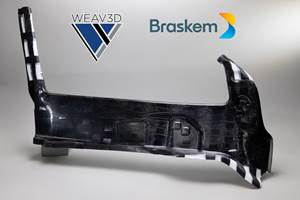Advanced Pultrusion Takes Off In Commercial Aircraft Structures
Innovative prepreg pultrusion process forms profiles equal to autoclaved components at lower cost.
The properties of advanced composites are highly attractive to aerospace engineers, in particular the high stiffness-to-weight ratio of carbon fiber-based components. For straight profiles, such as stiffeners and simple beams, aluminum extrusions are very cost-effective, especially when compared to the same profiles produced by the hand layup/autoclave methods typical of commercial aircraft composite parts.
ADvanced Pultrusion (ADP), a unique process developed by JAMCO Corp. (Mitaka, Tokyo, Japan), combines the advantages of hand layup, namely high mechanical properties, with the automation of the pultrusion process. The result is lower-cost profiles with exceptionally high straightness characteristics and fiber volumes as high as 65 percent. Unlike traditional pultrusion, which uses dry fibers pulled through a catalyzed liquid resin bath, the ADP process makes use of aerospace-approved prepreg systems, so the cost of material qualification is minimized.
Development driven by evolving customer needs
Founded in 1955 as an aircraft maintenance company, JAMCO is a major producer of commercial aircraft galleys, lavatories and interior panels, and has approximately 1,100 employees split between several divisions, worldwide. Customers include all of the major airplane builders and many airlines.
The development of the ADP process began at JAMCO's Aircraft Components Co. in the middle of 1980, explains Art Sogabe, general manager of marketing and sales. At the time, JAMCO was in production of stanchions for the Boeing 757 cargo compartment, using traditional pultrusion. In need of improved properties for other Boeing applications under consideration, including the 777 aircraft, then in development, JAMCO began experimenting with pultrusion of aerospace-grade prepregs. Although Boeing opted for other methods, such as autoclave, for profile production on the 777, JAMCO continued refining the process and, by 1995, produced a T-shaped profile that met Airbus' performance requirements. In 1996, the company started supplying ADP stiffeners and stringers to Airbus, beginning with the vertical tail of the A330-200. Airbus has since converted the stringers and stiffeners of the composite vertical tails of all Airbus planes to JAMCO's pultruded profiles (see photo, p. 37). These cured profiles are bonded to the composite skin panels during autoclave cure of the skins at Airbus' factory in Germany.
The 555-passenger Airbus A380, set for first flight in late 2004, with first commercial deliveries in 2006, also will use JAMCO's ADP profiles for the stiffeners and stringers of the huge vertical tail. These will be significantly larger than the stiffeners and stringers used on existing Airbus aircraft. To support the upper deck floor panels in the double-decked passenger compartment of the fuselage, Airbus has sourced JAMCO to provide pultruded carbon fiber/epoxy I-beams, the first use of ADP for an interior structure. To maximize usable space in the passenger cabins, the cross-floor beams, as they are called, for the upper deck must span the entire fuselage width without the intermediate supports commonly used for lower or main deck flooring, which bridges the cargo compartment. At its maximum, the upper deck cabin is 5.92m/19.42 ft wide, a considerable span for an end-clamped beam. Airbus' Jens Hinrichsen, the leader of the vertical tailplane component management and integration team for the A380 and the former director of structures for Airbus, notes that the floor beams are critical elements of the primary fuselage "framework." The beams are subject to internal pressure and vertical floor loads, as well as horizontal wind gusts, and are built to keep the fuselage cross-section in its intended shape.
Automation and prepreg keys to process
Manufacture of profiles using the ADP process begins with rolls of carbon fiber/epoxy prepreg, slit to required widths for achieving the final shape and dimensions. The number of rolls and fiber orientations vary with the specific profile, explains Sogabe. Since prepreg is used as the starting material, any combination of fiber orientations is possible, with unidirectional tapes and woven fabrics — including ±45° fabrics — commonly employed. Fiber angles can be held to a tolerance of ±1°, compared to ±4° tolerance for traditional pultrusion, while minimum thickness of 0.2 mm/0.08 inch is possible, less than half that of traditional pultrusion. Problems associated with resin advancement and inconsistencies in fiber/resin ratio are eliminated through the use of prepreg. And Sogabe says any prepreg can be used in the ADP process, including controlled-flow and high-viscosity, toughened systems that are not practical in liquid molding processes. For the vertical tail profiles, HexPly 6376 epoxy prepregs, using Tenax/Toho HTA fibers are provided by Hexcel Composites (Duxford, Cambridge, U.K.). According to Hinrichsen, Airbus is still evaluating several prepreg systems for the A380 upper deck floor cross beams, with selection planned for later in 2003.
The ADP process is inline but, unlike traditional pultrusion, it is intermittent rather than continuous. The prepregs are pulled through a series of preforming stations, where guides and rollers gradually combine and fold the prepreg sheets into the desired shape, including angles, I-beams, single and double-T, Z or hat cross-sections. No tackifiers are required to maintain proper shape of the preform. The flow of uncured prepreg stops at the pressing die where heated, segmented metal molds close onto the preform to complete the consolidation and cure the resin at pressures around 1 Mpa/145 psi and temperatures up to 250°C/482°F. The time and temperature of the curing step varies in accord with the cure rheology of the selected resin.
For the HexPly 6376, the pressing step is approximately one hour at 180°C/356°F, resulting in about 70 percent cure of the prepreg — enough "green strength" to maintain rigidity for subsequent freestanding postcure.
Once the die opens and retracts from the part, the flow of material is restarted and the cured section moves into a flow-through postcure oven. Uncured prepreg is simultaneously pulled into the die, where the curing process begins again. The postcure oven, set at 180°C/356°F, is long enough to contain several pressed sections of the continuous profile. During approximately two hours in the oven, the cure is advanced from 70 percent to fully cured. Die length need not be geared to part length. In the case of the cross-floor I-beam, a complete part is several times longer than the pressing die, so each beam requires several pressing/pulling sequences to form. Sogabe emphasizes that JAMCO developed a special intermittent version of the traditional "tractor" puller that can be coordinated with the opening of the pressing die to pull uncured prepreg in, stop exactly where required to press and cure the next section, then restart when the pressing die opens again an hour later. The saw also is synchronized with the molding dies and cuts the profiles to the exact length required for subsequent processing or shipment.
JAMCO's experience with the ADP process for solid profiles is extensive, and cross-sections have been produced ranging from 50 mm by 50 mm (2 inches by 2 inches) through 250 mm by 100 mm (10 inches by 4 inches), with thickness from 0.2 mm/0.08 inch to 10 mm/0.40 inches. While the floor beams represent some of the biggest parts ever produced by the process, ADP has no real length limitation. The largest parts produced to date are I-beam sections 250 mm/10 inches high, 100 mm/4 inches wide, and 7m/23 ft long, and larger parts can be fabricated by expanding the dimensions of the molds and associated equipment.
An important advantage of ADP, especially for primary aircraft structure, is that finished parts have void contents under 1 percent (similar to autoclave-cured parts), compared to up to 3 percent for traditional pultrusion. JAMCO verifies part integrity with an automated ultrasonic inspection station, where the cut part is fully examined via a water-immersion, pulse-echo method.
Post molding operations include trimming, drilling and bonding operations as required. An outer peel ply layer can be applied to any profile during the ADP process, and later removed to provide a bonding surface without a secondary abrasion step. JAMCO also has developed a special five-axis milling machine to trim and cut holes in the floor cross beams.
Prepared for growth
Sogabe emphasizes that the ADP process is not limited to straight, solid profiles — JAMCO also has demonstrated production of long profiles incorporating honeycomb cores, as well as laminated curved beams. The capacity of a single line using a typical aerospace epoxy resin is 30,000m/100,000 ft per year. JAMCO is considering the use of faster-curing resins to increase annual capacity.
The A380 represents a substantial gain in production for the ADP process, and JAMCO's Mitaka facility recently underwent a 1,600m2/17,220 ft2 expansion to meet the supply requirements for the new aircraft. JAMCO engineers are on site at Airbus in Germany to assist in the design and integration of the pultruded profiles for the vertical tail and upper deck. Delivery of the first shipset of A380 parts occurred in the second quarter of 2003.
To date, JAMCO's sales of pultruded profiles have been limited to the aerospace market, but Sogabe says the company is actively pursuing applications outside aerospace, such as high-performance automotive and industrial components. While production today takes place only in Japan, JAMCO is prepared to expand internationally, should commercial considerations warrant such a move. For the immediate future, the A380 business is providing a sizable opportunity for the growth of this unique process.
Related Content
Plant tour: Albany Engineered Composites, Rochester, N.H., U.S.
Efficient, high-quality, well-controlled composites manufacturing at volume is the mantra for this 3D weaving specialist.
Read MoreBraskem demonstrates PP solutions using Weav3D composite lattice technology
Partnership combines Braskem’s polypropylene sheets with Weav3D Rebar for Plastics technology to address new structural, automotive applications requiring high-strength, lightweight material solutions.
Read MorePEEK vs. PEKK vs. PAEK and continuous compression molding
Suppliers of thermoplastics and carbon fiber chime in regarding PEEK vs. PEKK, and now PAEK, as well as in-situ consolidation — the supply chain for thermoplastic tape composites continues to evolve.
Read More3D-woven composites find success in aerospace, space
CAMX 2024: Bally Ribbon Mills experts are displaying the company’s various joints, thermal protection system (TPS) technologies and other 3D woven composites for mission-critical applications.
Read MoreRead Next
Developing bonded composite repair for ships, offshore units
Bureau Veritas and industry partners issue guidelines and pave the way for certification via StrengthBond Offshore project.
Read MoreVIDEO: High-volume processing for fiberglass components
Cannon Ergos, a company specializing in high-ton presses and equipment for composites fabrication and plastics processing, displayed automotive and industrial components at CAMX 2024.
Read MoreAll-recycled, needle-punched nonwoven CFRP slashes carbon footprint of Formula 2 seat
Dallara and Tenowo collaborate to produce a race-ready Formula 2 seat using recycled carbon fiber, reducing CO2 emissions by 97.5% compared to virgin materials.
Read More



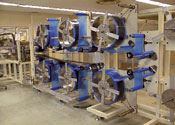
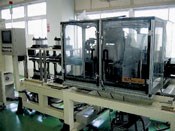
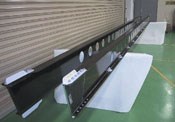

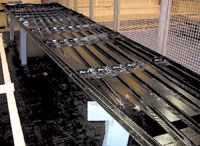
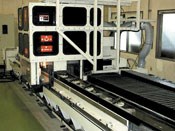










.jpg;maxWidth=300;quality=90)

